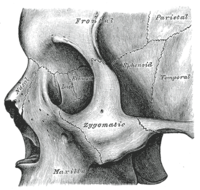
Photo from wikipedia
In mammals, the infraorbital canal provides a passage for the infraorbital ramus of the maxillary branch of the trigeminal nerve. The infraorbital nerve ensures tactile sensitivity of the upper teeth… Click to show full abstract
In mammals, the infraorbital canal provides a passage for the infraorbital ramus of the maxillary branch of the trigeminal nerve. The infraorbital nerve ensures tactile sensitivity of the upper teeth and face between the eye and upper lip and, more significantly, the innervation of mystacial vibrissae (whiskers). In contrast, most non-mammalian synapsids display a more “reptilian-like” ancestral condition in which a long and ramified maxillary canal completely enclosed the infraorbital nerve along with other branches of the trigeminal nerve. The phylogenetic transition from the ancestral “reptilian-like” to the derived “mammal-like” condition has been hypothesized to occur at the base of the Probainognathia clade. Using μCT and synchrotron scanning, this study aims to document this transition in detail by focusing on a sample of non-mammalian probainognathian cynodonts and early mammaliaforms. We find that the mammalian condition is the result of a gradual shortening of the maxillary canal, which enabled the infraorbital nerve to ramify within the soft tissues of the face. Mobile whiskers became possible only after the mammalian infraorbital nerve had evolved, which suggest that these structures appeared in Probainognathus and more derived cynodonts. Finally a foramen located on the ventral margin of the lacrimal bone, which has been often homologized with the infraorbital foramen of derived Probainognathia and early Mammaliaformes, is most probably homologous to the mammalian zygomaticofacial foramen.
Journal Title: Journal of Mammalian Evolution
Year Published: 2019
Link to full text (if available)
Share on Social Media: Sign Up to like & get
recommendations!